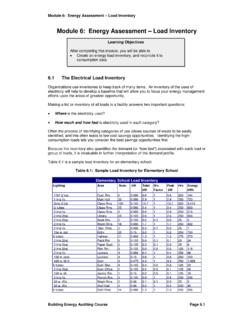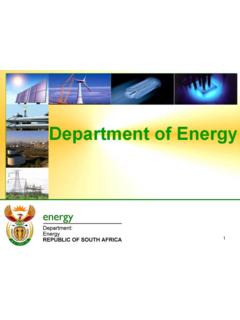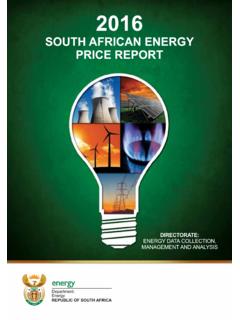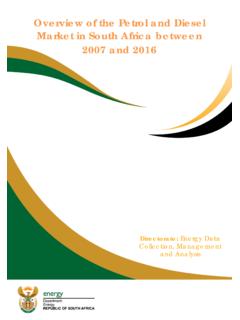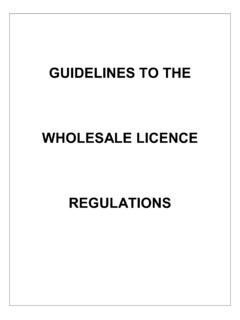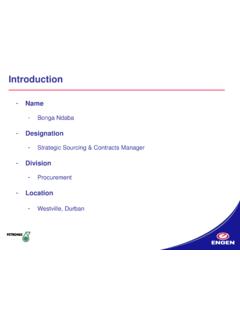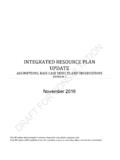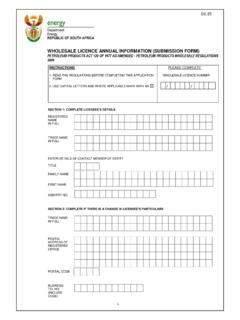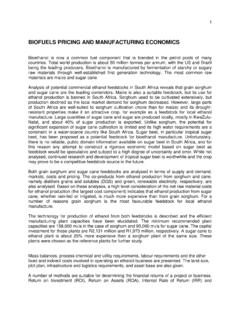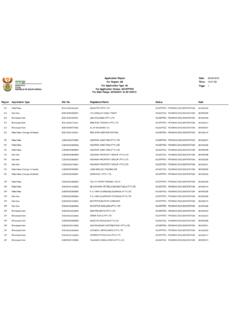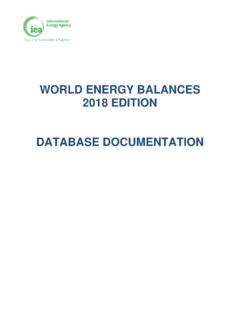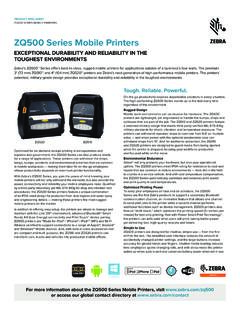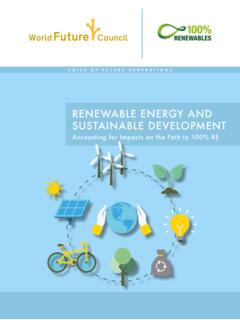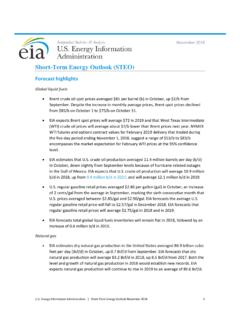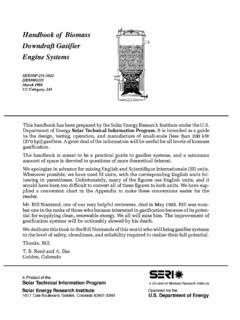Transcription of THE SOUTH AFRICAN ENERGY SECTOR REPORT 2019
1 THE SOUTH AFRICAN ENERGY SECTOR REPORT 2019iDIRECTORATE: ENERGY DATA COLLECTION, MANAGEMENT AND ANALYSISTHE SOUTH AFRICAN ENERGY SECTOR REPORTTHE SOUTH AFRICAN ENERGY SECTOR REPORT 2019iiDISCLAIMERWHEREAS THE GREATEST CARE HAS BEEN TAKEN IN THE COMPILATION OF THIS PUBLICATION, THE DEPARTMENT OF ENERGY RELIES ON DATA PROVIDED BY VARIOUS SOURCES AND DOES NOT HOLD ITSELF RESPONSIBLE FOR ANY ERRORS OR OMISSIONS EMANATING AS A CONSEQUENCE OF PROVISION OF INACCURATE, INCORRECT OR INCOMPLETE DATA FROM SUCH SOUTH AFRICAN ENERGY SECTOR REPORT 2019iiiDIRECTORATE: ENERGY DATA COLLECTION, MANAGEMENT AND ANALYSIS Compiled by: Ms Keneilwe RatshomoEmail: Ramaano NembaheEmail: by:Department of EnergyPrivate Bag X96 Pretoria0001 Tel: (012) 406 7540192 Visagie Street, Cnr.
2 Paul Kruger & Visagie Street, Pretoria, 0001 Website: SOUTH AFRICAN ENERGY SECTOR REPORTTHE SOUTH AFRICAN ENERGY SECTOR REPORT 2019ivDEPARTMENT OF ENERGYD irector-General Mr. T. ZuluENERGY POLICY AND PLANNING BRANCHD eputy Director-General Mr. O. AphaneENERGY PLANNING CHIEF DIRECTORATEC hief Director: Mr. T. AudatENERGY DATA COLLECTION, MANAGEMENT AND ANALYSIS DIRECTORATED irector Ms. V. OlifantPUBLISHED IN 2019 ISBN: 978-1-920435-17-2 COPYRIGHT RESERVEDTHE SOUTH AFRICAN ENERGY SECTOR REPORT 2019vContents PagesForeword 1 Introduction 2 List of Abbreviations 3 Key ENERGY Policies and Legislations 41.
3 ENERGY SUPPLY Crude oil and Petroleum Products Natural gas Electricity Coal Renewables Nuclear 222. ENERGY DEMAND Industrial SECTOR Mining Iron and steel Chemicals Non-Ferrous Metals Non-Metallic Minerals Food and Tobacco Pulp and Paper Commerce and Public Services SECTOR Agricultural SECTOR Transport SECTOR Residential SECTOR 35 References 36 THE SOUTH AFRICAN ENERGY SECTOR REPORT 2019viList of TablesTable 1-1: Refinery production capacity 9 Table 1-2: Crude Oil imports volumes by country of origin, 2016 12 List of FiguresFigure 1-1.
4 Total primary ENERGY supply, 2016 8 Figure 1-2: Crude oil primary supply, 2016 10 Figure 1-3: Crude oil imports by region, 2016 11 Figure 1-4: Petroleum products supply, 2016 12 Figure 1-5: Petroleum products imports by region, 2016 13 Figure 1-6: Natural gas primary supply, 2016 14 Figure 1-7: Electricity supply, 2016 15 Figure 1-8: Electricity Generation, Transmission and Distribution 16 Figure 1-9: Power Station Maximum Generating Capacity Mix 17 Figure 1-10: Coal primary supply, 2016 18 Figure 1-11: Allocated capacity in windows 1, 2, 3 and 4, 2017 21 Figure 2-1: ENERGY demand by SECTOR , 2016 23 Figure 2-2: ENERGY demand by industrial sub-sectors, 2016 24 Figure 2-3: ENERGY demand in the industrial SECTOR , 2016 25 Figure 2-4: ENERGY demand in mining, 2016 25 Figure 2-5: ENERGY demand in Iron and Steel industry, 2016 26 Figure 2-6: ENERGY demand in Chemical and Petrochemical industry, 2016 27 Figure 2-7: ENERGY demand in non-ferrous metals, 2016 28 Figure 2-8: ENERGY demand in non-metallic minerals, 2016 29 Figure 2-9: ENERGY demand in food and tobacco, 2016 30 Figure 2-10: ENERGY demand in pulp and paper industry, 2016 31 Figure 2-11: ENERGY demand in the commerce and public services SECTOR , 2016 32 Figure 2-12.
5 ENERGY demand in the agriculture SECTOR , 2016 33 Figure 2-13: ENERGY demand in the transport SECTOR , 2016 34 Figure 2-14: ENERGY demand in the residential SECTOR , 2016 35 THE SOUTH AFRICAN ENERGY SECTOR REPORT 20191 ForewordIt is with the greatest appreciation and honour to introduce the 2019 SOUTH AFRICAN ENERGY SECTOR REPORT . This REPORT presents us with an opportunity to inform and update all the relevant stakeholders about the latest ENERGY demand and supply trends in SOUTH Africa as prescribed in the National ENERGY Act of 2008. The REPORT is based on the 2016 ENERGY balance compiled by the Department of ENERGY (DoE) and mainly focusses on analysing ENERGY supply and the subsequent consumption broken down into various sectors of the REPORT is published annually with data and analysis based on the latest published SOUTH AFRICAN ENERGY Balances.
6 We have made remarkable progress in improving the overall quality of our ENERGY data in order to ensure that accurate, timely and reliable data is provided in all our publications and hope that this REPORT will become a source of reference among ENERGY analysts in SOUTH Africa and abroad. We will continuously collaborate with all our data providers to ensure that our ENERGY data is of highest possible quality. I extend my most sincere thanks and appreciation to the ENERGY Data Collection, Management and Analysis Directorate for the hard work that went into the compilation of this publication. I would also like to extend my appreciation to all the ENERGY data providers and stakeholders for their concerted efforts and support during the process of compiling this REPORT .
7 Comments and inputs are welcome and could be addressed to T. Zulu Director GeneralDepartment of EnergyTHE SOUTH AFRICAN ENERGY SECTOR REPORT 20192 Introduction ENERGY is at the heart of development ( world Bank, 2019). ENERGY is also the vital force that powers businesses, manufacturing, the transportation of goods and the delivery of services to the nation. It is the lifeblood of modern living, as it has an impact on everything we do and affects our very existence. ENERGY is therefore an enabler for economic growth and ENERGY SECTOR in SOUTH Africa has been, and continues to be, at the center of the economic and social development.
8 The industry directly affects the economy by using labour and capital to produce ENERGY . This role is particularly important when economic growth and job creation are such high priorities in the country. In addition to the ENERGY SECTOR s economic contributions in general, relatively lower and stable ENERGY prices are very instrumental in stimulating the country`s the country`s economy continues to grow, the Department of ENERGY is mandated to ensure that ENERGY resources are available, and that there`s access to ENERGY services in an affordable, reliable and sustainable manner, while minimizing the associated adverse environmental National Development Plan (NDP)
9 Envisages that by 2030 SOUTH Africa will have an ENERGY SECTOR that promotes economic growth and development through adequate investment in ENERGY infrastructure. The plan also envisages that by 2030 SOUTH Africa will have an adequate supply of electricity and liquid fuels to ensure that economic activities and welfare are not disrupted, and that at least 95% of the population will have access to grid or off-grid SOUTH AFRICAN ENERGY SECTOR is dominated by coal, which is plentiful and cheap, and is ranked among the lowest ENERGY costs in the world . Apart from coal, which contributed around 69% to the total primary ENERGY supply in 2016, SOUTH Africa gets ENERGY locally from biomass, such as wood and dung, natural gas, hydro-power, nuclear power, solar power and wind.
10 In this REPORT , the 2016 SOUTH AFRICAN ENERGY balance is analysed by breaking it down per sub-sectors, that is, the total primary ENERGY supply which includes domestic production as well as imports and exports and total final consumption which includes the economic sectors, industry, transport, agriculture, commercial and public as well as residential sectors. There is also a further breakdown into the various industry subsectors in terms of ENERGY consumption. The purpose of this REPORT is therefore to show how and in what proportions the country s available ENERGY is supplied and consumed by different SOUTH AFRICAN ENERGY SECTOR REPORT 20193 List of Abbreviations bbl/dBarrels per DayCAIAC hemical and Allied Industries AssociationCEFC entral ENERGY Fund CTLCoal-To-LiquidDMRD epartment of Mineral Resources DOED epartment of ENERGY GDPG ross Domestic ProductGTLGas-To-LiquidIEPI ntegrated ENERGY PlanINEPI ntegrated National Electrification Programme IRPI ntegrated Resource Plan JPoIJohannesburg Plan of Implementation LPGL iquified Petroleum Gas
